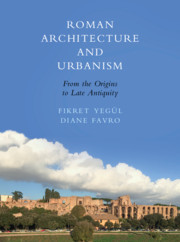Book contents
- Roman Architecture and Urbanism
- Roman Architecture and Urbanism
- Copyright page
- Contents
- Preface and Acknowledgments
- Maps
- Introduction
- 1 Urban Design and Architecture in Rome and Italy during the Republic and the Early Empire
- 2 Temple Architecture of Republican Rome and Italy
- 3 Technology of Building
- 4 Julio-Claudian Architecture in Rome
- 5 Residential Architecture
- 6 Imperial Architecture in Rome from the Flavians through the Antonines
- 7 Architecture and Planning in Italy and the Western Provinces
- 8 Architecture and Planning in North Africa
- 9 Greece under Roman Rule
- 10 Architecture and Planning in Asia Minor
- 11 The Roman Near East
- 12 The Late Empire in Rome and the Provinces
- General Bibliography
- Glossary
- Index
- Plate Section (PDF Only)
- References
General Bibliography
Published online by Cambridge University Press: 21 August 2019
- Roman Architecture and Urbanism
- Roman Architecture and Urbanism
- Copyright page
- Contents
- Preface and Acknowledgments
- Maps
- Introduction
- 1 Urban Design and Architecture in Rome and Italy during the Republic and the Early Empire
- 2 Temple Architecture of Republican Rome and Italy
- 3 Technology of Building
- 4 Julio-Claudian Architecture in Rome
- 5 Residential Architecture
- 6 Imperial Architecture in Rome from the Flavians through the Antonines
- 7 Architecture and Planning in Italy and the Western Provinces
- 8 Architecture and Planning in North Africa
- 9 Greece under Roman Rule
- 10 Architecture and Planning in Asia Minor
- 11 The Roman Near East
- 12 The Late Empire in Rome and the Provinces
- General Bibliography
- Glossary
- Index
- Plate Section (PDF Only)
- References
- Type
- Chapter
- Information
- Roman Architecture and UrbanismFrom the Origins to Late Antiquity, pp. 863 - 866Publisher: Cambridge University PressPrint publication year: 2019



